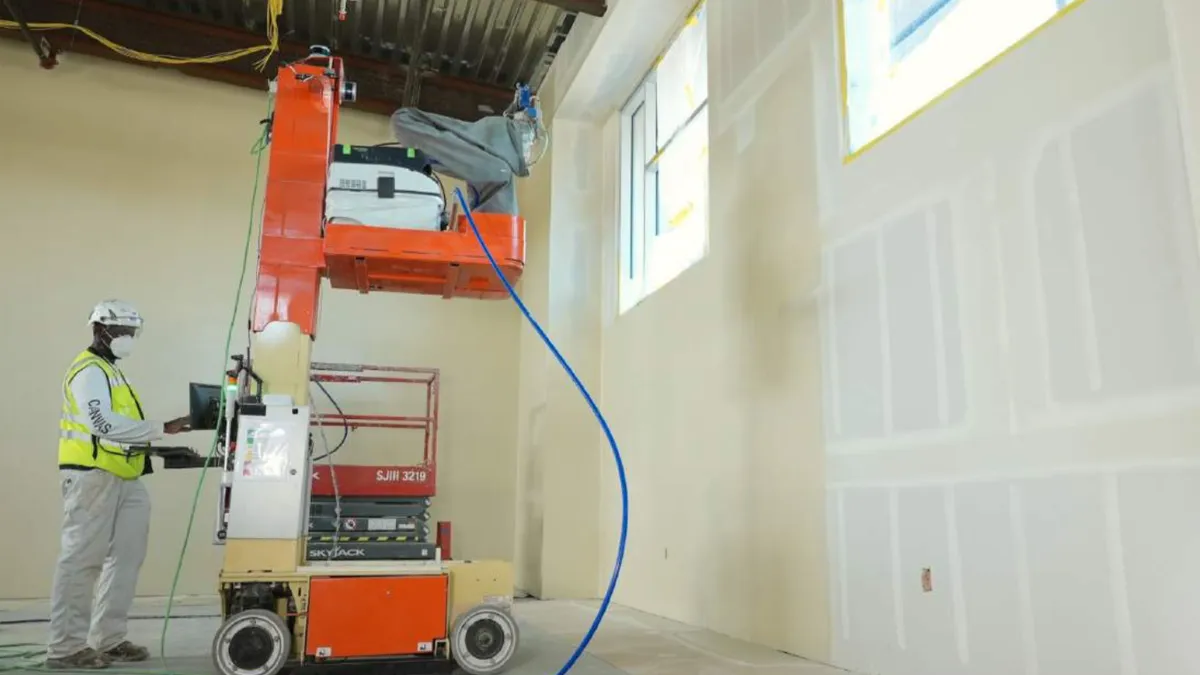Dive Brief:
- A San Francisco-based startup has made robots on the jobsite a reality in the form of a drywall taping and finishing machine that combines a 17-foot-high scissor lift with a robotic arm. The robot from Canvas is operated by humans to apply tape, spray mud and sand for a Level 5+ finish on walls while cutting a seven day job to just two.
- Commercial contractors including Webcor, Swinerton and Suffolk Construction have partnered with Canvas, whose drywall technology has been used at the Harvey Milk Terminal at San Francisco International Airport, the University of California, San Francisco's Wayne and Gladys Valley Center for Vision, the Newark (California) Civic Center and at the recently completed Chase Center Towers, adjacent to the Golden State Warriors' new basketball arena in San Francisco.
- Canvas recently announced a $24 million Series B funding round led by Menlo Partners that also included Suffolk, Alumni Ventures Group and existing investors Innovation Endeavors, Brick & Mortar Ventures, Obvious Ventures and Grit Labs. That brought Canvas's cumulative funding to $43 million since being founded in 2017 within Otherlab, a San Francisco-based private research lab.
Dive Insight:
Canvas is a signatory to District Council 16 of the International Union of Painters and Allied Trades, but it doesn't pitch itself as a drywall subcontractor. Instead, the company trains and hires union workers for projects as a subcontractor.
One example was the 73,000-square-foot Newark, California, Civic Center project. Webcor employed Canvas robots to finish drywall in several rooms where the robotic arm, run by workers on site, taped, sprayed and sanded each surface to a Level 5 finish, the highest quality benchmark in the industry.
"It's all computer-generated. It knows how many millimeters to spray on the wall. Nobody is mixing mud, nobody is spraying or holding the nozzle. As a result, the wall looks magnificent," said Derek Stevens, drywall operations manager at Webcor, in a release.
According to a case study emailed to Construction Dive, instead of needing six days to produce a Level 5 finish, Canvas allowed taping and spraying to be completed on the first day, which meant there was only a single drying cycle needed before sanding.
Use of the robot reduced the cycle time for a Level 5 finish by 34% and resulted in 99.9% dust recapture to create a safer worksite during the COVID-19 pandemic while putting workers at less risk, since they didn't have to work on the 17-foot ceilings manually.
Taking humans out of the equation is another benefit of using the robot. According to Canvas, drywall finishing and framing has the highest prevalence of work-related musculoskeletal disorder cases among such trades, with as many as one in four workers experiencing such effects.
Robert Williams III, business manager for IUPAT's District Council 16, said a tool like Canvas helps mitigate those impacts.
"It is creating meaningful union career opportunities, helping introduce previously untapped communities to the trades and making the work itself safer and reducing the strain on the body," Williams said.













